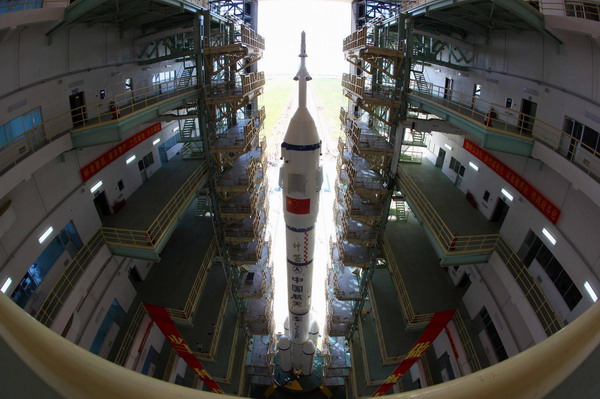Launch platform readied for space mission
Updated: 2012-06-10 07:31
(China Daily)
|
||||||||
By 10:30 am on Saturday, the spacecraft and its carrier rocket, the Long March-2F, had been moved to the launch platform at the Jiuquan Satellite Launch Center in Northwest China, signaling the preparation work for the mission has entered the last stage, the anonymous spokesperson said in a public statement.
Zhou Jianping, chief designer of the manned space program, said at the launch center on Saturday that the mission will be "a significant step in China's space history", because the spacecraft will send astronauts into a space lab for the first time, instead of just carrying them to circle the Earth in previous three manned missions.
Zhang Yonghua, deputy chief designer of the launch center system, said that the air-conditioning and fire-fighting systems in the launching tower have been improved for this manned mission so as to strengthen facilities' stability and ensure the safety of astronauts.
 |
|
Shenzhou-IX manned spacecraft and its carrier rocket, the Long March-2F, have been moved to the launch platform at the Jiuquan Satellite Launch Center in Northwest China, June 9, 2012. [Photo/Xinhua] |
The spokesperson said that Shenzhou IX and its carrier rocket were delivered to the Jiuquan Satellite Launch Center in early April this year.
The Tiangong-1, or Heavenly Palace-1, was lowered to the docking orbit in early June and is now orbiting normally.
The final preparations are running smoothly, and the selected astronauts have completed their training and are in sound physical and mental condition, said the spokesperson, without specifying their names.
Niu Hongguang, deputy commander-in-chief of the country's manned space program, said earlier that the three-person crew on Shenzhou IX might include female astronauts, but the final selection would be decided based on conditions near the time of launch.
It is a regular practice for China's space program to name the crew for a specific mission until only a couple of days before the mission kicks off.
China picked two women and five men from a few thousands of candidates to become the second batch of seven astronaut trainees in 2010. Both women were former fighter jet pilots.
"The manned space program would not be complete without women's participation," said Jiao Weixin, an Earth and space scientist with Peking University.
Earlier reports said that one of the three Shenzhou IX crew members will not board the Tiangong-1 space module lab, but will remain inside the spacecraft as a precautionary measure in case of emergency.
Jiao said that although manual space docking usually has a higher success rate than robotic space docking, it will "pose a bigger challenge for astronauts".
The launch will be China's fourth manned spaceflight, after three successful missions between 2003 and 2008 that put six astronauts in space.
China's manned spaceflight program aims to build a 60-ton space station around 2020, based on a three-step plan.
The first has been successfully completed, after four unmanned spacecraft and two manned spacecraft were launched between 1999 and 2005 to transport men between Earth and space.
The second step aims to master the key technologies used for assembling a space station. Shenzhou VIII with three men on board achieved the country's first extravehicular activity in 2008. With that ability, astronauts can work outside a space station.
Last November the unmanned space lab module Tiangong-1 docked with the unmanned Shenzhou VIII spacecraft in China's first space docking mission. The rendezvous and docking technology is necessary for space station assembly. After that, Tiangong-1 went into long-term operations in space awaiting docking attempts of Shenzhou IX and Shenzhou X.
By Xinhua and China Daily

 Relief reaches isolated village
Relief reaches isolated village
 Rainfall poses new threats to quake-hit region
Rainfall poses new threats to quake-hit region
 Funerals begin for Boston bombing victims
Funerals begin for Boston bombing victims
 Quake takeaway from China's Air Force
Quake takeaway from China's Air Force
 Obama celebrates young inventors at science fair
Obama celebrates young inventors at science fair
 Earth Day marked around the world
Earth Day marked around the world
 Volunteer team helping students find sense of normalcy
Volunteer team helping students find sense of normalcy
 Ethnic groups quick to join rescue efforts
Ethnic groups quick to join rescue efforts
Most Viewed
Editor's Picks

|

|

|

|

|

|
Today's Top News
Health new priority for quake zone
Xi meets US top military officer
Japan's boats driven out of Diaoyu
China mulls online shopping legislation
Bird flu death toll rises to 22
Putin appoints new ambassador to China
Japanese ships blocked from Diaoyu Islands
Inspired by Guan, more Chinese pick up golf
US Weekly

|

|






